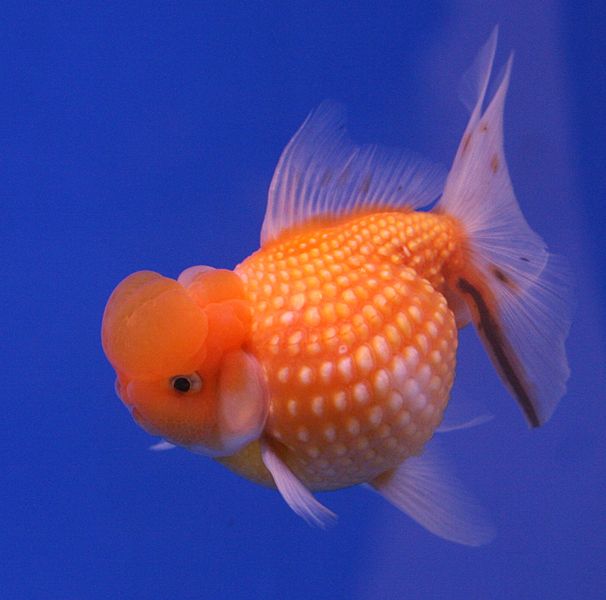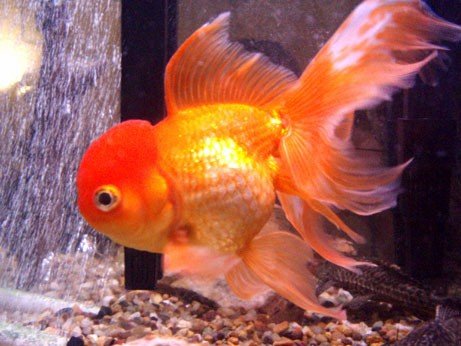 With the wide range of body shapes and colors, it is hard to believe that all of the fish we call “goldfish” come from the same ancestor, a rather dull, silver/brown carp known as Carassius auratus. Almost two thousand years ago, Asian fisherman raised these fish in ponds for food, and soon the natural orange and yellow mutations of these fish caught the eye of Chinese royalty. Over time, the fish that we know as “goldfish” were selectively bred for specific traits and colors which would eventually become the varieties we see in fish stores today. Let me introduce you to some of the most popular “breeds” that have become aquarium mainstays over the past few hundred years.
With the wide range of body shapes and colors, it is hard to believe that all of the fish we call “goldfish” come from the same ancestor, a rather dull, silver/brown carp known as Carassius auratus. Almost two thousand years ago, Asian fisherman raised these fish in ponds for food, and soon the natural orange and yellow mutations of these fish caught the eye of Chinese royalty. Over time, the fish that we know as “goldfish” were selectively bred for specific traits and colors which would eventually become the varieties we see in fish stores today. Let me introduce you to some of the most popular “breeds” that have become aquarium mainstays over the past few hundred years.
Made for Outdoor Living
Comets – Perhaps the closest in appearance to the “natural” carp, Comets have longer fins than the common goldfish, and are often sold as “feeder fish”. They can be orange, white, silver, yellow or black. They get fairly large and are often sold for ponds rather than aquariums. The Sarasa Comet is a very popular variety whose coloration is a combination of pure white and deep red.
Shubunkins – Shubunkins have a body shape similar to Comets, but their color is a calico mix of white, black, red, orange, grey and even steely blue on some individuals. These fish are sometimes known as the “Poor Man’s Koi” and indeed, their colors can resemble their highly prized cousins.
Wakins – Wakins, or Japanese Goldfish, have brilliant red and white coloration. While most of the body is still carp-like, Wakins have a split, double tail, giving it the fantail-like shape associated with fancier varieties. These are ideal pond fish, and are best admired from above.
Fantails – basic Fantail Goldfish are the basis of many of the other varieties. The tail is split and double like the Wakin, but the body is shorter. It is also rounder and more egg-shaped, rather than the long, slender, carp-like shape of the previous varieties.
Bringing that Outdoor Beauty In
Though many of the fancy varieties mentioned above were developed for outdoor ponds, some of the other fancy goldfish are best suited aquariums. The traits that these fish were bred for have some impact on their growth and health and while they may be housed outside in some climates and conditions year round, their ideal home is in an aquarium where they can be admired and cared for properly.
Telescopes – Telescope Goldfish have the squat, rounded bodies and the double tails. They also have large, round, bulging eyes that protrude from their skulls. The mutation gives the fish an endearing appearance, but the eyesight of Telescope Goldfish is fairly poor. The Telescope variety of goldfish also includes the very popular Moors, and the smaller Siamese or Chinese Dolls.
Celestial Eyes – Like Telescopes, the eyes of Celestial Eye Goldfish protrude. However, the eyes of this variety appear to be rotated with the pupils in a constant upward gaze. Some legends say that these fish were bred by monks to encourage man to always gaze towards Heaven. Celestial Eye Goldfish have gently rounded backs and do not have a dorsal fin. Since their eyesight is fixed, they cannot see in front of them and can be out-competed for food by more active or less “handicapped” varieties.
 Orandas – Oranda Goldfish are one of the most popular varieties. They have deep bodies and long, split double tails, like the Fantail. The most notable characteristic of these fish is the “brain” on top of their head – a soft,raspberry-like growth known as the “wen” that continues to grow as the fish grows. It may even obstruct the eyesight of older fish. The wen is prone to bacterial infections, especially in Orandas, who are sensitive to cooler temperatures. The Red Cap Oranda – a white fish with deep red wen – is one of the most popular color varieties.
Orandas – Oranda Goldfish are one of the most popular varieties. They have deep bodies and long, split double tails, like the Fantail. The most notable characteristic of these fish is the “brain” on top of their head – a soft,raspberry-like growth known as the “wen” that continues to grow as the fish grows. It may even obstruct the eyesight of older fish. The wen is prone to bacterial infections, especially in Orandas, who are sensitive to cooler temperatures. The Red Cap Oranda – a white fish with deep red wen – is one of the most popular color varieties.
Ryukins – Ryukins are admired for their uniquely-shaped, rounded bodies and very high, arched backs. The face of the fish is more pointed than other types. They are also more assertive than many other fancy types, so Ryukins should not be kept with docile or less agile varieties. Their deep body shape can cause digestive complications, causing the fish to float on its side; added vegetable matter in their diet and a day a week without food can usually help to remedy the ailment.
Lionheads – Lionhead Goldfish are similar to Orandas, but they do not have dorsal fins. The Lionhead’s back slopes towards the rear of the fish where it meets the fan-tail. Like the Oranda, the Lionhead has a wen, but the Lionhead’s wen covers the head, cheeks and gill-plates. It may cover the eyes and impair the vision with time.
The Ranchu is a closely-related variant of the Lionhead. Ranchus have a more rounded, arched back and shorter, down-turned tail. Ranchu Goldfish are very popular and not as common as others, so they can be quite expensive. Competitions are held for the best Ranchu, both from the top view (as in a pond) and side view (as in an aquarium).
Bubble-eyes – Bubble-eye Goldfish are some of the most recognizable, bizarre and endearing. They develop a large fluid-filled “balloon” under each eye that wobbles as the fish swims. These fragile sacs can be ruptured on sharp surfaces, by aggressive tankmates, or on filter in-takes. Consider their environment and tankmates carefully as injuries to the sacs can become infected if they are damaged.
Pom-Poms – Pom-Pom Goldfish are recognized by the strange, abnormal growths on their faces. The outer edges of the nose are form balls that look like a cheerleader’s pom-poms. Like the wen on other goldfish, these balls can be vulnerable to fungus or bacteria. Like the sacs of bubble-eyes, they will usually grow back if they are ever damaged.
 Pearlscales – Pearlscale Goldfish are sometimes called Ping-Pong Goldfish due to their very round, ball-like body shape. The scales on these fish each grow a small calcium deposit on the edge that make the normally flat scale rounded and bead-like. This makes these goldfish more delicate than many others. Pearlscale goldfish have a mildly arched back and no wen on their head.
Pearlscales – Pearlscale Goldfish are sometimes called Ping-Pong Goldfish due to their very round, ball-like body shape. The scales on these fish each grow a small calcium deposit on the edge that make the normally flat scale rounded and bead-like. This makes these goldfish more delicate than many others. Pearlscale goldfish have a mildly arched back and no wen on their head.
These are just the basics of the fancy goldfish you may find! They can each be found in different color combinations of red, black, gold, yellow, blue, orange and others and even some of these varieties may be crossed with each other to give us fish like Crowned Pearlscales (Pearlscale x Oranda). And just think, all of this started from a plain silvery-brown fish in China!
Thanks,
Eileen
Calico Telescope image referenced from wikipedia and originally posted by Syberspace
Pearlscale image referenced from wikipedia and originally posted by Lerdsewa
 That Fish Blog – Aquarium Advice and Information
That Fish Blog – Aquarium Advice and Information


Dear Eileen
You seem all to be part of a cool crew…your article now as well is very informative and also adds to my pond inspiration!
One question I would like to ask; I find many ponds in our region where goldfish get these wart like humps. These are really disturbing to the eye and once the fish got them, they seem not to dissapear, even in winter time OR in summer for that matter. The fish do not seem to be influanced by this at all.
Could you kindly give advise?
Best fishes
Gert
Hi Gert, the growths may be natural and not disease related, depending on the type of fish they are…as you can see in the article mutations abound in the goldfish world. They may also be the result of a virus like koi pox, or even benign tumorous growths. It is difficult to say without seeing an example of what you see. If the fish eat normally and do not show signs of distress it probably isn’t anything to worry about and there may not be ant type of treatment. if you’re concerned and if you’re able to snap a clear pic, you can send it to marinebio@thatpetplace.com and maybe one of our biologists can help to identify.
I have a fantail goldfish that has a damaged gill plate. It looks like it was eaten by disease – about half of it is missing, the edge is ragged and the edge is white and slightly swollen. What is the cause and what can I do to treat this. It is in an aquarium, not a pond.
Hi John, if there is a fungal or bacterial disease involved, the first thing you’ll want to do is treat that ailment. Maracyn may be a good place to start, as it treats both bacterial and fungal issues, possibly follow up with a melafix treatment to help the tissue heal. Are there other fish in the tank?